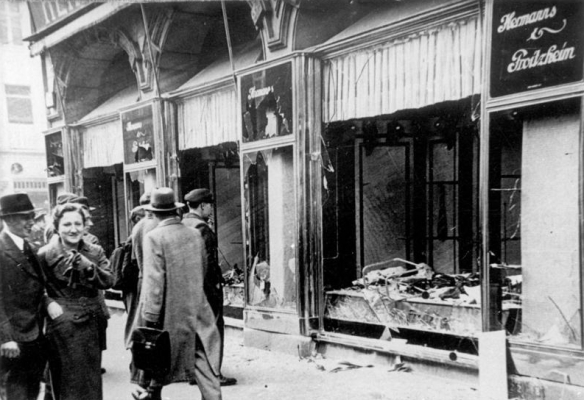
Photo from Magdeburg, Germany, Nov. 9-10, 1938, Kristallnacht (The Night of Broken Glass)
Today marks the 80th anniversary of The Night of Broken Glass (Kristallnacht).
The smiling man and woman in the photo are strolling past the broken glass of raided shops of the Jewish shopkeepers in the otherwise tranquil city of Magdeburg, Germany. The passers-by likely have never heard of Mechtild of Magdeburg, the 13th Century mystic beguine who had declared that “No one can burn the truth,” nor had they heard the screams or seen the tears of the shopkeepers or synagogue worshipers. Those screams are silent now. (Scroll down for information on Krystallnacht, The Night of Broken Glass.)
Like the synagogues of Germany, Austria, and the Sudetenland, the Tree of Life Synagogue in Pittsburgh had been a quiet place. The sound of broken glass were heard only during from the traditional breaking of a glass at Jewish weddings. Tree of Life was a sacred place of worship. But the memory of Kristallnacht and the long history of anti-Semitic pograms were, and are, never far away.
The 80th anniversary of Kristallnacht deserves greater attention in the U.S.A. this year when the evil of white nationalism has shattered the glass of the ‘others’ in synagogues, churches, and public gathering places with the weapons of destruction. Today I hear the echoes from The Night of Broken Glass and see the faces of smiling passers-by. I stand still again in the face of evil and bow my knee before the Eternal Silence of the compassionate God we cannot kill.
- Gordon C. Stewart, Chaska, MN, November 10, 2018.
U.S. Holocaust Museum account of Kristallnacht
On the night of November 9, 1938, violent anti-Jewish demonstrations broke out across Germany, Austria, and the Sudetenland region of Czechoslovakia. Nazi officials depicted the riots as justified reactions to the assassination of German foreign official Ernst vom Rath, who had been shot two days earlier by Herschel Grynszpan, a 17-year old Polish Jew distraught over the deportation of his family from Germany.
Over the next 48 hours, violent mobs, spurred by antisemitic exhortations from Nazi officials, destroyed hundreds of synagogues, burning or desecrating Jewish religious artifacts along the way. Acting on orders from Gestapo headquarters, police officers and firefighters did nothing to prevent the destruction. All told, approximately 7,500 Jewish-owned businesses, homes, and schools were plundered, and 91 Jews were murdered. An additional 30,000 Jewish men were arrested and sent to concentration camps. Nazi officials immediately claimed that the Jews themselves were to blame for the riots, and a fine of one billion reichsmarks (about $400 million at 1938 rates) was imposed on the German Jewish community.
The Nazis came to call the event Kristallnacht (“Crystal Night,” or, “The Night of Broken Glass”), referring to the thousands of shattered windows that littered the streets afterwards, but the euphemism does not convey the full brutality of the event. Kristallnacht was a turning point in the history of the Third Reich, marking the shift from antisemitic rhetoric and legislation to the violent, aggressive anti-Jewish measures that would culminate with the Holocaust.

Regarding the smiling woman on the day after Kristallnacht, my best guess is she eventually lost a couple of sons to the war, as well as her home, and perhaps even her walking partner. In 1999 I was in Leipzig with the Mount Calvary Lutheran Church choir, housed with a lovely elderly lady. On a chest of drawers she had a chunk of burned wood — what was left of her home after the bombings.
If one doesn’t care what happens to the “other,” what makes anyone think they can remain silent as these things develop and not feel the sting eventually. “And there was no one left to stand up for me” — Niemoller’s complaint.
LikeLiked by 1 person
Thank you, Mona, for reminding us of your experience with the elderly woman in Leipzig and its application. We acquiesce to atrocious suffered by the “other” to our our own peril: the loss of compassion and our deepest humanity.
LikeLike
You have no idea how much I feel like a Jew in 1934 Germany these days.
LikeLike
The parallels are frightening, Marilyn. We have to light the candles of hope. Give Garry a hug — for him and for yourself. You both need hugs. Peace, Gordon
LikeLike
It is fearsome to think that we seem on the verge and beginning to tip into that kind of hell again. I hope the election results will begin to yank us back from that horror.
LikeLike
I join you in that hope, Carolyn.
LikeLike
Thank you for this Gordon. It’s ever more important to seek truth and remember.
❤
LikeLiked by 1 person
It is, Nancy. It is.
LikeLiked by 1 person
Thank you Gordon, we need to remember.
❤
LikeLike
You’re most welcome. Thanks for coming by.
LikeLike
Your text
LikeLike
Hi Rev! ???
LikeLike